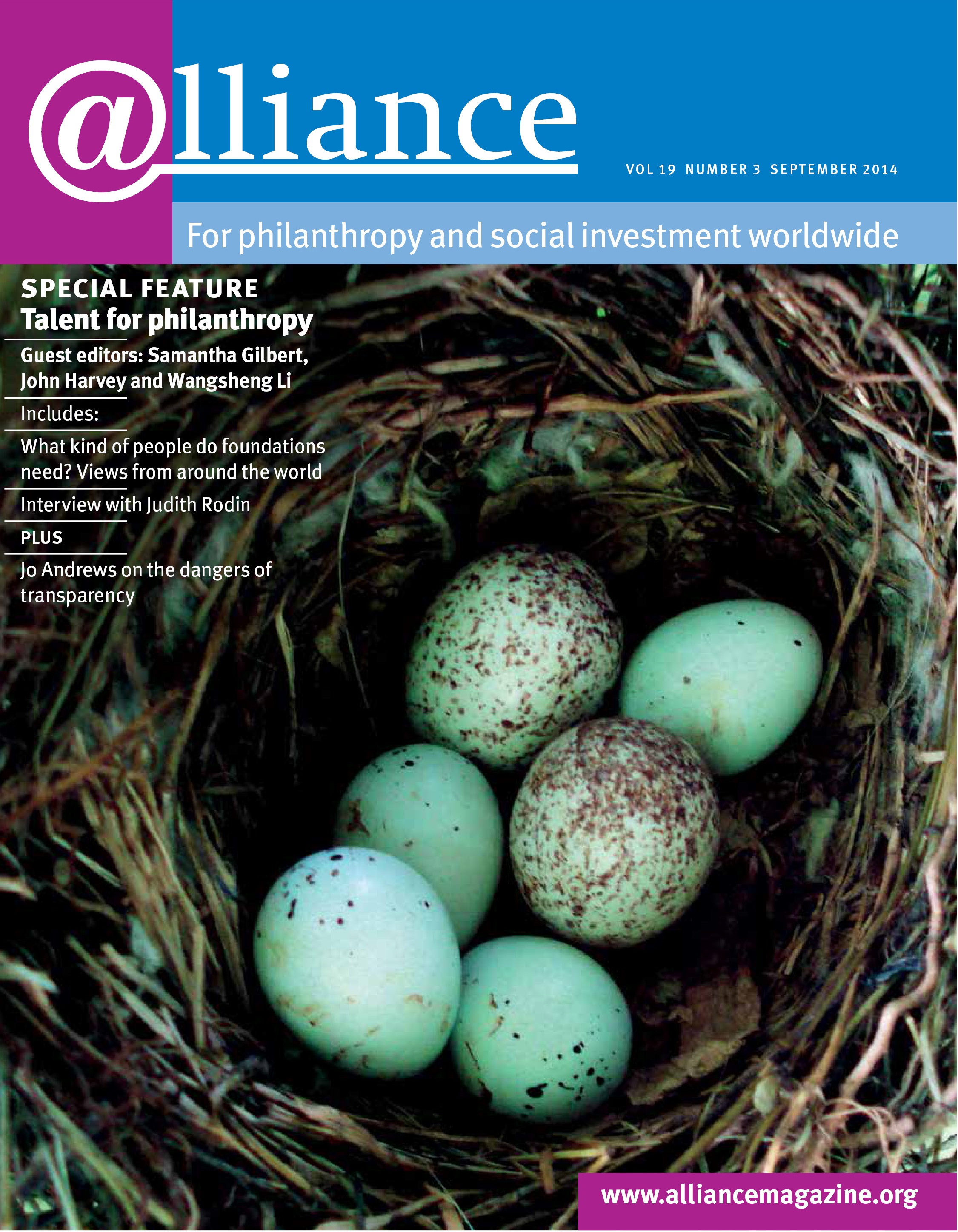In 2013, Oxford University’s Said Business School launched an impact investing programme. In the two courses we’ve completed, students have come from more than 20 different countries, representing organizations ranging from the World Bank, KPMG, Credit Suisse and private equity firms to philanthropic advisory firms and social enterprises. We seek to impart the technical skills they need for issue-area expertise and management assessment, and the financial skills to analyse investment opportunities, develop appropriate investment vehicles, structure the deal and measure multiple impacts. Just as important, we try to expose students to some of the issues tied to creating social change and reinforce the message that impact investing involves a conscious effort to positively and negatively shape human and natural capital. A somewhat different mindset from investing for financial return is involved – the key message being ‘Do no harm’.
This diverse group of people has naturally brought very real differences in the approach to impact investing, and some important questions have surfaced in class discussions:
- Are we willing to talk about and learn from failure? Many students come from a culture in which failure is not discussed. Others said that they were afraid to discuss projects that didn’t meet objectives for fear of being undercut by competitors or appearing weak before others in a new field in which actors are trying to establish themselves. However, experienced impact investors (among them, our class tutors) argue that failure must be part of the learning process because speaking the truth can only serve to strengthen individual investments and the field.
- What is our attitude to partnership? Students and tutors talked about the importance of learning from other investors, and of including communities in the development and testing of projects. Others disagreed, noting again the fear of competition or the added difficulty of managing different approaches or agendas when working in partnership.
- How do we manage expectations? Impact investing is a hot topic, which brings with it the risk of promising too much. How do we keep the topic hot while being pragmatic?
- How do we balance our different backgrounds? Some people argue that a financial background should be the priority in the identification of staff for investment projects, while others believe that social sector experience is just as important, if not more important, to achieve meaningful impact.
- How do we define social return? This is a vexed question on which there is still no agreement (though GIIRS and IRIS have helped move this conversation solidly forward in terms of tools and guidance).
As the course has evolved, I have worked with colleagues and impact investors from around the world to attempt to address some of these questions and provide lessons for our students.
Some things impact investors wish they had known before investing
In addition to my work with Oxford University, I have been conducting hundreds of interviews with impact investors, philanthropists and social investors from around the world about lessons and trends in social investing.[1] Below are some of the things the impact investors said they wished they had known before investing:
- If you come into this space asking ‘When will I see returns?’, it’s not for you. More often than not, you should take a long view, because we are talking about a new model of development in which change may not happen in three to five years.
- Investors from the traditional investment world should avoid coming to the table with fixed ideas. Investors need to be willing to consult with communities to assure alignment of approaches and outcomes.
- Likewise, individuals coming into this space from the social sector must be willing to understand the importance of meeting agreed criteria and producing a sustainable financial return.
- It is important to develop a network that keeps you informed and aware of promising practice and projects to have a pipeline of strong and aligned opportunities.
- Investors must ask themselves ‘What is our edge?’ If you can’t answer this question, you need to partner with others to ensure the best possible outcomes.
- You must define your exit strategy and idea of long-term impact. However, trying to create a larger impact and engaging more and bigger investors in a project could lead to a dilution of social impacts. This is a fine line that must be managed throughout an investment partnership.
- Sometimes it is not enough to be only a financial backer. Limited capacity among emerging businesses means that to have a robust pipeline investors should be willing to consider an approach that involves guidance, skills building and working to shape an enabling policy environment.
- On-the-ground presence is critical. An office in Switzerland cannot adequately represent local needs and interests in Cambodia.
In general, we have seen that regardless of where they come from, investors are learning the importance of humility, partnership, and communities to create innovative solutions. The human considerations are just as important as financial ones. This is particularly important in emerging economies because our research has found that in these regions impact investing is being seen not as an add-on or an experiment but as a development alternative and a new opportunity for creating multiple layers of social and economic change. It is also an effective way to bring in large amounts of new, local capital to help solve social problems.
The Oxford team hopes to instil these and other hard-won lessons in the students, but also something more, something that often isn’t talked about on the impact investing conference circuit or in the increasing number of academic courses. Our goal is to send students away grounded in the principles and practice of doing no harm.
Do no harm
Even when we have the best intentions, there can be risk and damage. We have heard stories of impact investors who come to the table with savvy financial skills but little understanding of the complex and interconnected social change systems they are entering. When you dive into the world of impact investing you are tackling the world’s most complex challenges. Failure happens. Challenges must be faced. Recalibrations must be made. These are wicked problems with no easy answer.
Through the Impact Investing Programme we help students find their moral compass and understand legal and financial risk. What are the threats and opportunities they will face? What can go wrong? How can they maximize social and environmental benefits while minimizing risk? Students learn to ask these questions through real-life case studies.
Students learn to ask these questions through sharing experiences, real-life case studies, and the new Impact Investing Workbook we created, which challenges their assumptions.
Estimates are that impact investing will grow to between US$400 billion and US$1 trillion over the next decade. Its future is exciting. However, with any fast-growing field, we need to be deliberate in our actions and to talk frankly about what can go wrong, what the risks are and what we are learning to accelerate positive social and financial returns. The world of impact investing is evolving in part on the backs of the world’s most vulnerable communities. We have a responsibility to get it right as quickly as possible.
Case study: investing in a sweet potato farming venture in Ghana
Agriculture in Africa is one of the leading areas of growth and opportunity for impact investors. It creates jobs, eliminates hunger, improves health outcomes and builds stable communities.
Imagine that you are presented with a US$22 million deal to invest in a sweet potato farming venture in the Afram Plains in Ghana, with an expected 10 per cent return in five years. You are helping 80,000 smallholder farmers, most of them women, increase their yields fivefold, create jobs and reduce hunger. Afram Plains is an emerging food basket in Ghana, rich in natural resources from farming and fishing. Yet 87 per cent of this rural population live in poverty. Farming investments offer hope and access to credit and capital. [2]
Current investors are US, European, and African foundations, impact investors and multilaterals. You have been invited to join them to expand the farming opportunities. You scratch beyond the deal sheet and learn:
- Several pesticides used on the farm are banned in investors’ countries, and two pesticides, dangerous to aquatic species, are banned by 137 countries and the UN – but not by Ghana.
- No study was done to establish whether the market could bear the increase of sweet potatoes from 80,000 new farmers.
- Children work on the farm with their parents after they come home from school. This is an agrarian community.
As an investor, what would you do? Would you raise the issues with the other investors? Would you tackle cultural questions like child labour with the local farmowner? Would you be willing to work on alternative solutions to pesticides, even if it meant less profit for you? Would you provide funding to ensure that the long-term health impact of the pesticides was monitored? What would you do if someone became ill from using one of the banned substances? Whose well-being is really at the centre of your investment?
1 This research is for the forthcoming book Good, Evil, Wicked: The art, science, and business of giving, produced by Partners for Change and published by Stanford University Press.
2 Drawn from the case study ‘The Triple Bottom-Line and Impact Investing: The case of Afram Plains District of Ghana’. For the case study and teaching guide visit>
Gayle Peterson is associate fellow, Said Business School, Oxford University and programme director, Impact Investing. Email gpeterson@sbs.ox.ac.uk



Comments (0)